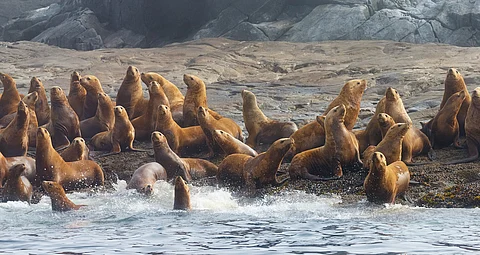

Marine mammals in the Arctic and Subarctic regions suffer from both short-term as well as long-term impacts of marine heat waves (MHWs), a new study has warned.
Increased mortality, decreased reproductive rates, and susceptibility to disease are some of the impacts of MHWs on marine mammals of the Arctic, as per the study.
The Arctic Ocean is predicted to be a future MHW hotspot. These are periods where ocean temperatures substantially exceed historical norms in a given region, with durations ranging from several days to in some cases, years.
An MWH can span from a few to thousands of kilometres.
According to the researchers, an MWH happens when anomalies in sea surface temperature (SST) surpass their local 90th percentile threshold for at least five consecutive days or longer.
For the current study, the scientists reviewed literature on MHW characteristics and ecological impacts in the Arctic and Subarctic seas, and contrasted MHW characteristics between the Bering Sea and Barents Sea, marginal seas which are the main pathways to the Arctic Ocean.
“Throughout the review, we especially draw on studies linked to the Bering Sea and Chukchi Sea MHWs in 2017-2019, and to a lesser extent to the 2014-2016 MHW event (the “Blob”) in the northeast Pacific as well as some global model studies,” the paper noted.
Besides marine mammals, they also uncovered the pervasive impacts of MHWs across widely different organism groups, including benthic foundation species, phytoplankton, zooplankton, fish and seabirds.
The experts noted that upper trophic level (UTL), homeothermic vertebrates like seabirds (all birds that use the marine environment), and marine mammals generally showed a delayed response to MHW events, “due to their trophic distance from primary productivity and lower trophic levels, longer life spans, and high mobility”.
Moreover, their stores of blubber and fat usually buffer interruptions to the food web.
However, this same blubber can become an impediment for some Arctic cetaceans, like narwhals (Monodon monoceros) and bowhead whales (Balaena mysticetus) to dissipate heat from their bodies.
“Narwhals, in particular, have limited physiological flexibility to adjust their swimming or diving behaviour to thermoregulate if water temperatures become extreme. Given evidence that the distributional range of Arctic marine mammals is temperature driven, MHW events could have potentially direct negative impacts on these species,” the researchers wrote.
They also noted that high marine mammal mortality has been documented during extended warm periods, including humpback whales (Megaptera novaeangliae) and fin whales (Balaenoptera physalus) following the 2014-2016 Gulf of Alaska MHW.
There can be more immediate direct and indirect effects of MHWs on Arctic and Subarctic marine mammals. MHWs can result in toxic algae blooms and diseases that directly affect UTLs.
“The first recorded mortality of a polar bear (Ursus maritimus) from avian influenza occurred in the winter of 2024; the bear was likely infected by scavenging on infected marine birds, which has broad conservation and health issues for mammalian species, including humans,” according to the paper.
Marine mammals can also suffer from reduced abundance and low calf production in the long run, besides high mortality.
The paper added that following the Gulf of Alaska MHW, changes in distribution by humpback whales and their prey resulted in higher entanglement of whales in fishing gear farther south, due to greater temporal and spatial overlap of whales and fisheries.
It added that while some Subarctic breeding animals may adjust to warm conditions by foraging farther north, those that reside in the Arctic year-round do not have that option. “For example, following the warm conditions in the northern Bering and Chukchi seas, ice-seals like spotted seal (Phoca largha) had high mortality and their pups were in poor condition (Huntington et al., 2020).”
Arctic and Subarctic marine heatwaves and their ecological impacts was published on February 19 in the journal Frontiers in Environmental Science.